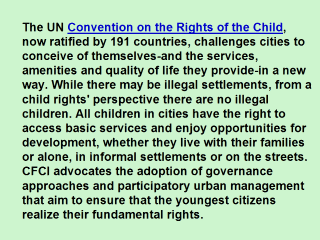 |
In high-,
middle- and low-income nations alike, including several European
countries, a growing number of municipalities have made the political
decision to become "child friendly". The process aimed to
building a CFC is synonymous with the implementation of the Convention in
a local governance setting and incorporates a number of characteristics
that put children front and centre.
1. Children's participation: promoting children's active
involvement in issues that affect them; listening to their views and
taking them into consideration in decision-making processes
2. A child friendly legal framework: ensuring legislation, regulatory
frameworks and procedures which consistently promote and protect the
rights of all children
3. A city-wide Children's Rights Strategy: developing a detailed,
comprehensive strategy or agenda for building a Child Friendly City, based
on the Convention
4. A Children's Rights Unit or coordinating mechanism: developing
permanent structures in local government to ensure priority consideration
of children's perspective
5. Child impact assessment and evaluation: ensuring that there is a
systematic process to assess the impact of law, policy and practice on
children - in advance, during and after implementation
6. A children's budget: ensuring adequate resource commitment and
budget analysis for children
7. A regular State of the City's Children Report: ensuring sufficient
monitoring and data collection on the state of children and their rights
8. Making children's rights known: ensuring awareness of children's
rights among adults and children
9. Independent advocacy for children: supporting non-governmental
organizations and developing independent human rights institutions -
children's ombuds-people or commissioners for children - to promote
children's rights.
|
